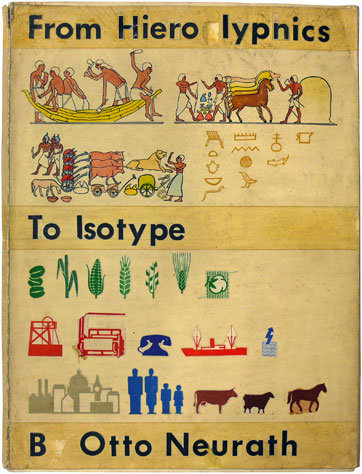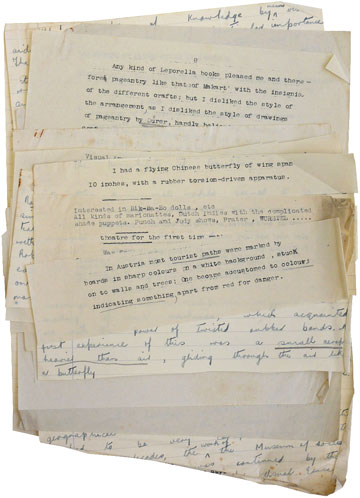
From hieroglyphics to Isotype
cover design / mock-up, Otto Neurath / Isotype Institute, c.1944, (I.C. 3.2/87)
From 1943 until his death in December 1945, Otto Neurath worked tirelessly on numerous versions of an innovative 'visual autobiography' titled From hieroglyphics to Isotype. After his death, only extracts from the original text appeared in print: as 'From hieroglyphics to Isotypes' [sic] in Future books: the crowded scene (volume III, 1947), heavily edited by Neurath's widow, Marie Neurath, and the film-maker Paul Rotha; and later in Empiricism and sociology, edited by Marie Neurath and Robert S. Cohen (1973).
Otto Neurath initially conceived From hieroglyphics to Isotype as a 'PICTURE BOOK, with a few explanatory notes only', adding that its purpose would be to 'show the different sources from which Isotype has evolved'. He wanted to reveal Isotype's genealogy by penetrating to its roots, looking at heraldic, allegorical, tattoo and playing card symbols; military drawings and battle plans; maps; still and moving photographic images; and projection and perspective presentations - in total, looking at instances of how 'the visual elements of a comprehensive visual language combine'.

Having formulated his intentions, there followed a flurry of writing and research. Neurath collated his ideas by making notes piecemeal on small scraps of paper (above; I.C. 3.2/76), which were stuck together and appended to his first rough draft. He added extensive notes for the book's contents, and long, detailed lists of chapters and of illustrations to be included from his own extensive and rich collection of 18th- and 19th-century ephemera.
Early drafts of Neurath's text received less than favorable criticism from Wolfgang Foges, managing director of the book packager Adprint (handling the book's production), who regarded the text (only half-jokingly) as self-absorbed Isotype propaganda. Neurath was advised to focus on and expand the biographical notes featured in the book's epilogue 'Glimpses at a visual autobiography', and this he did with enthusiasm and aplomb. In subsequent drafts, Neurath thus shifted his emphasis from the evolution of Isotype to a personal exploration of the visual stimuli that had engaged, challenged and influenced his life and work.
To show his conception of the book, Neurath created two mock-ups of it, including a rough cover design (shown at top), exacting page layouts and numerous examples of illustrative material. He composed further extensive and exacting lists of illustrations from books, prints, periodicals and journals for inclusion. Simply put, Neurath wanted it to be a big book 'with lots of pictures'.
Some sixty-five years on, work is now underway to collate the several variant texts of the visual autobiography held in the Otto and Marie Neurath Isotype Collection. The aim is to produce a judiciously edited and well-illustrated edition under the title From hieroglyphics to Isotype: a visual autobiography. Publication by Hyphen Press is planned for 2010. (ME)
area of research: Otto Neurath's 'visual autobiography' (Eve, Burke)











